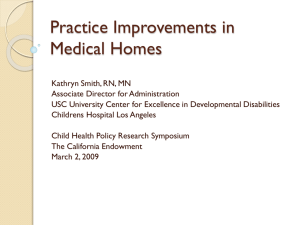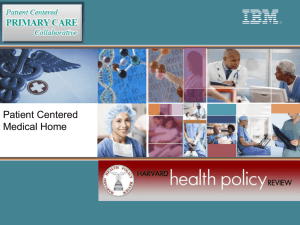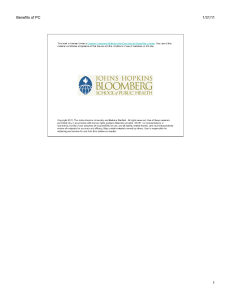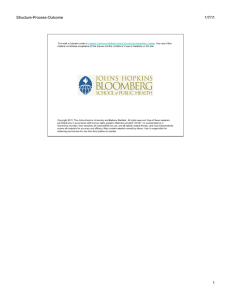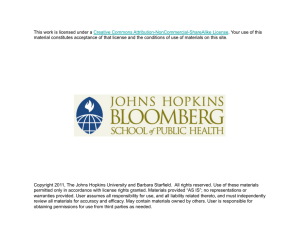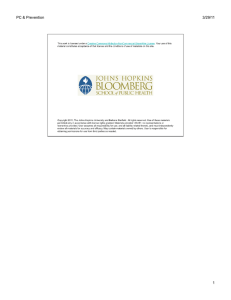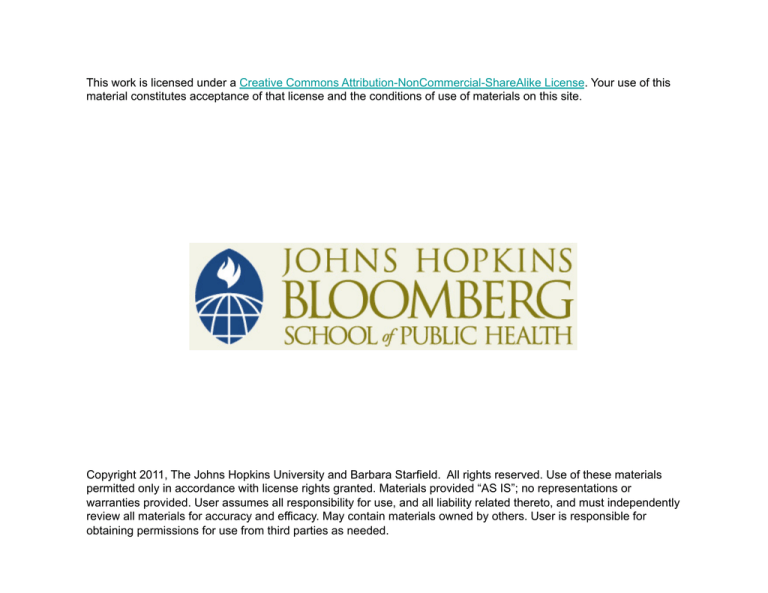
This work is licensed under a Creative Commons Attribution-NonCommercial-ShareAlike License. Your use of this
material constitutes acceptance of that license and the conditions of use of materials on this site.
Copyright 2011, The Johns Hopkins University and Barbara Starfield. All rights reserved. Use of these materials
permitted only in accordance with license rights granted. Materials provided “AS IS”; no representations or
warranties provided. User assumes all responsibility for use, and all liability related thereto, and must independently
review all materials for accuracy and efficacy. May contain materials owned by others. User is responsible for
obtaining permissions for use from third parties as needed.
Primary Care and Specialty
Care Issues
Barbara Starfield, MD, MPH
Primary Care Course
(Based on Cape Town, South Africa, 2007;
and Barcelona, Spain, 2009)
This presentation discusses the
role of specialists, i.e., non-primarycare physicians, in health systems
at a time of increasing recognition
of the importance of a primary care
orientation in health systems. It
concludes that a reassessment of
their roles is an imperative, at least
in some countries.
Starfield 02/11
PCB 7463
Although much is known
about the characteristics
and contributions of primary
care, little is known about
the characteristics and
contributions of specialist
care.
Starfield 04/07
SP 6709
What is the right number of
specialists?
What do specialists do?
What do specialists contribute
to population health?
Starfield 01/06
SP 6527
We know that
1. Inappropriate referrals to specialists lead to
greater frequency of tests and more false positive
results than appropriate referrals to specialists.
2. Inappropriate referrals to specialists lead to poorer
outcomes than appropriate referrals.
3. The socially advantaged have higher rates of visits
to specialists than the socially disadvantaged.
4. The more the subspecialist training of primary
care MDs, the more the referrals.
A MAJOR ROLE OF PRIMARY CARE IS TO ASSURE
THAT SPECIALTY CARE IS MORE APPROPRIATE
AND, THEREFORE, MORE EFFECTIVE.
Sources: Starfield et al, Health Aff 2005; W5:97-107. van Doorslaer et al, Health Econ
2004; 13:629-47. Starfield B, Gervas J. Comprehensiveness v special interests: Family
medicine should encourage its clinicians to subspecialize: Negative. In: Kennealy T,
Buetow S, ed. Ideological Debates in Family Medicine. Nova Publishing, 2007.
Starfield 08/05
SP 6322
Concomitant with increasing rates
of diagnosis and comorbidity is the
increased role played by specialists
in some health care systems.
Increasing use of specialists
creates more challenges to
maintaining person-focused care
rather than disease-focused care.
Starfield 08/05
SP 6460
Royal College of Physicians and Surgeons
Task Force (Canada) to Review Fundamental Issues
in Specialty Education
GENERALISM
SPECIALISM
Knowledge
Breadth
Depth
Multidisciplinary
Single discipline
Undifferentiated
Differentiated
Prevention, investigation/ management/
rehabilitation and chronic care
Investigation/management
Disease is considered in the context of
multiple systems and the whole.
Disease is considered in the context of a
single system.
Community- and hospital-based
Hospital-based
Skills
Predominantly non-invasive
Predominantly invasive
Attitudes
Holistic
Reductionist
Starfield 01/09
SP 7034 n
Why are specialists
needed?
Starfield 01/07
SP 6650
Functions of Specialist Care
Assistance with diagnosis
Advice on treatment
Definitive treatment
1. Short-term
2. Long-term (ongoing management)
a. Shared responsibility
b. Transferred responsibility
Starfield 01/03
SP 5982
We know very little about which
specialties take over management of
(a) Patients - all problems
(b) Patients - a specialty problem only
and for how long.
We need this information to better plan
for the deployment of specialist
resources.
Starfield 10/00
SP 5603
Specialist care can be
associated with worse
outcomes if it is not
adequately coordinated
with primary care.
Starfield 01/07
SP 6651
Percentage of People Seeing at
Least One Specialist in a Year
US
Canada
(Ontario)
40% of total population; 54% of
patients (users)
31% of population (68% at ages
65 and over)
UK
about 15% of patients (at ages
under 65)
Spain
30% of population; 40% of
patients (users)
Sources: Peterson S, AAFP (personal communication, January 30, 2007). Jaakkimainen et al. Primary
Care in Ontario. ICES Atlas. Toronto, CA: Institute for Clinical Evaluative Sciences, 2006. Sicras-Mainar
et al, Eur J Public Health 2007; 17:657-63. Starfield et al, J Ambul Care Manage 2009;32:216-25.
Starfield 01/07
SP 6646 n
Use of Specialists in the US
• REFERRAL rates from primary care to
specialty care in the US are HIGH.
• Between 1/3 and 3/4 (depending on
the type of specialist) of visits to
specialists are for routine follow-up.
• The percentage of people SEEN BY a
specialist in a year is high, especially
in the presence of high morbidity
burden.
Sources: Forrest et al, BMJ 2002; 325:370-1. Valderas et al, Ann Fam Med 2009;7:104-11.
Starfield 03/06
SP 6567
In the United States,
about one-half of all
visits by “new” patients
are to specialists.
Source: Forrest & Reid, Health Aff 1997; 16:157-62.
Starfield 10/00
SP 5601
In the US in 2002-2004, 46% of all
visits to physician specialists in a
year were for routine follow-up of
existing diagnoses.
54% of all referred visits to
physician specialists were for
routine management or preventive
care.
Source: Valderas et al, Ann Fam Med 2009;7:104-11.
Starfield 04/07
SP 6729
Relationship with Regular Doctor
Percent:
AUS
CAN
GER
NZ
UK
US
Has regular doctor
92
92
97
94
96
84
5 years or more
56
60
76
57
66
42
8
8
3
6
4
16
NO regular doctor
Source: 2005 Commonwealth Fund International Health Policy Survey: Adults with Health Problems
Starfield 04/08
IC 6984 n
We know exactly what primary
care is and how to measure it.
We know almost nothing about
what specialty care is and how
to measure it.
Starfield 03/06
SP 6568
Horizontal Inequity Indices for Specialist Care Use in 17
Countries, 2000 or Nearest Available Year
Note: Specialist care is inequitable (in this case, favoring high income groups) if the 95% confidence limit is significantly different
from zero. This is so for all countries, except the United Kingdom, the Netherlands, and Norway.
Sources: de Looper & Lafortune, OECD Health Working Paper No. 43 (
http://www.olis.oecd.org/olis/2009doc.nsf/LinkTo/NT00000DE2/$FILE/JT03260782.PDF).
van Doorslaer & Masseria, OECD Health Working Paper No. 14 (
http://fiordiliji.sourceoecd.org/vl=22046792/cl=47/nw=1/rpsv/cgi-bin/wppdf?file=5lgsjhvj7phb.pdf).
Starfield 05/09
EQ 7236 n
How Frequently Do Specialists Take Care of
People with “Specialty” Conditions?
% of episodes
Cardiologists
36% of those with cardiac disease
Orthopedists
22% of of those with musculoskeletal disease
Neurologists
40% of those with nervous system disease
Factors other than age, gender, and overall “morbidity burden”
determine whether a patient will be seen by a specialist or not,
and how much it will cost. Episodes in which a specialist is
seen are more expensive.
Source: Spitzer, ACG Users Conference, 9/2000.
Starfield 10/00
SP 5602
With the possible exception of
long-term management for very
uncommon conditions and for
elderly patients with high
degrees of morbidity, specialists
play a lesser role in the care of
patients than do primary care
physicians.
Starfield 09/03
SP 5981
Average Number of Visits Per Year to Primary Care
and Specialists by Morbidity Burden, Comorbid
Conditions, Managed Care Organizations, 1996
*
*
*
*p<.0001
Based on data in Starfield et al, Ann Fam Med 2003; 1:8-14.
Starfield 08/08
SP 7004 n
Average Number of Visits Per Year to Primary
Care and Specialists by Morbidity Burden,
Comorbid Conditions, Medicare
8.95
9
*
Mean Number of Visits
8
6.57
7
6
5
3.9 *
4
3
2
2.12
4.32
* 1.8
1
0
Low-medium
High
Very high
Morbidity Group
*p<.0001
Primary Care Physician
Source: Starfield et al, Ann Fam Med 2005; 3:215-22.
Specialist
Starfield 08/08
SP 7005 n
Percentage of Visits by Type of Visit and
Specialist, US, 2004
Known patient
New
patient
New
Routine
problem Recurrence followup Other
Family physicians
7
46
6
38
3
General internists
7
34
6
50
3
Pediatricians
5
57
2
36
1
All primary care
7
45
5
41
3
Medical specialists
17
18
7
56
2
Surgical specialists
20
39
7
32
2
OB/GYN
7
19
2
71
2
Psychiatrists
10
5
13
70
2
Source: Valderas, 2009 NAMC analyses
Starfield 08/09
SP 7189 n
What do specialists
contribute to outcomes?
Starfield 09/03
SP 6119
Problems with an Excessive
Focus on Specialist Care
Poorer generic and some disease-specific
outcomes
More unnecessary diagnostic and
therapeutic intervention
Higher costs
Greater inequities in health care and health
Source: Starfield et al, Health Aff 2005;W5:97-107.
Starfield 04/04
SP 6232
SP 6117
• The higher the ratio of medical specialists to
population, the higher the surgery rates,
performance of procedures, and expenditures.
• The higher the level of spending in geographic
areas, the more people see specialists rather
than primary care physicians.
• Quality of care, both for illnesses and
preventive care, are no better in higher
spending areas, and in most cases are worse.
(Data controlled for sociodemographic characteristics, comorbidity, and severity of illness)
Sources: Welch et al, N Engl J Med 1993; 328:621-7. Fisher et al, Ann Intern
Med 2003; 138:273-87. Baicker & Chandra. Health Aff 2004; W4(April 7):
184-197 (http://content.healthaffairs.org/cgi/reprint/hlthaff.w4.184v1.pdf).
Starfield 09/04
SP 6117
Specialty services are more
costly than primary care
services, both from the
systems viewpoint and from
the viewpoint of individuals
followed over time. This is
especially the case for
medical subspecialists.
Sources: Starfield & Shi, Health Policy 2002; 60:201-18.
Franks & Fiscella, J Fam Pract 1998; 47:105-9. Baicker
& Chandra, Am Econ Rev 2004; 94:357-61.
Starfield 05/06
SP 6588
There are large variations in
both costs of care and in
frequency of interventions.
Areas with high use of
resources and greater supply
of specialists have NEITHER
better quality of care NOR
better results from care.
Sources: Fisher et al, Ann Intern Med 2003; Part 1: 138:273-87; Part 2: 138:288-98. Baicker &
Chandra, Health Aff 2004; W4:184-97. Wennberg et al, Health Aff 2005; W5:526-43.
Starfield 12/05
SP 6518
Patients receiving care from
specialists providing care outside
their area of specialization have
higher mortality rates for
community-acquired pneumonia,
acute myocardial infarction,
congestive heart failure, and
upper gastrointestinal
hemorrhage.
Source: Weingarten et al, Arch Intern Med 2002; 162:527-32.
Starfield 09/04
SP 6231
For elderly patients with diabetes,
disease oriented specialists adhere
to guidelines related to diabetes
better than primary care physicians,
but there are no differences in
adherence to other guidelines, in
short-term outcomes or satisfaction,
and much lower costs for family
physicians.
Source: Chin et al, Med Care 2000; 38:131-40.
Starfield 04/04
SP 6254
Although specialists usually do better at
adhering to disease-oriented guidelines,
generic outcomes of care (especially but not
only patient-reported outcomes) are no
better and are often worse than when care is
provided by primary care physicians.
Studies finding specialist care to be superior
are more likely to be methodologically
unsound, particularly regarding failure to
adjust for case mix.
Sources: Hartz & James, J Am Board Fam Med 2006; 19:291-302. Chin et al, Med Care 2000;
38:131-40. Donohoe, Arch Intern Med 1998; 158:1596-1608. Bertakis et al, Med Care 1998;
36:879-91. Harrold et al, J Gen Intern Med 1999; 14:499-511. Smetana et al, Arch Intern Med
2007; 167:10-20. Other studies reported in: Starfield et al, Milbank Q 2005; 83:457-502.
Starfield 04/07
SP 6764
Between 1960 and 2000, specialist
physician supply increased markedly –
much more than primary care physician
supply – in the US. But within the US,
the greater the specialist supply, the
worse the outcomes for COMMON
conditions.
Source: Starfield et al, Health Aff 2005;W5:97-107.
Starfield 09/09
SP 7209
In 35 US analyses dealing with differences
between types of areas (7) and 5 rates of
mortality (total, heart, cancer, stroke, infant),
the greater the primary care physician
supply, the lower the mortality for 28. The
higher the specialist ratio, the higher the
mortality in 25.
Above a certain level of specialist supply, the
more specialists per population, the worse
the outcomes.
Controlled only for income inequality
Source: Shi et al, J Am Board Fam Pract 2003; 16:412-22.
Starfield 11/06
SP 6459 n
Need and Number of
Neonatologists
• Variation in number of neonatologists per
population of births does not vary with
measures of need (VLBW ratios).
• There is no relationship between the
supply of neonatal care resources and
infant mortality.
• Increases in the supply of neonatologists
beyond a moderate level confer no
additional benefit.
Source: Goodman et al, N Engl J Med 2002; 346:1538-44.
Starfield 09/03
SP 6121
After adjustment for neonatal and
maternal characteristics, the neonatal
mortality rate in neonatal intensive care
units was lower in regions with 4.3
neonatologists per 10,000 births than in
those with 2.7 per 10,000 (OR .93).
Further increases in the number of
neonatologists were not associated
with greater reductions in death rates.
Source: Goodman et al, N Engl J Med 2002; 346:1538-44.
Starfield 08/02
SP 5914
In the US, as compared with other
industrialized nations, there are
• twice as many coronary artery
bypass procedures as the next
highest country and three times the
average
• one-third more coronary
angioplasties than the next highest
country, and over twice as many as
the average
Source: OECD. Health at a Glance, 2003.
Starfield 12/05
SP 6515
High specialist supply is
also associated with later
(rather than early) stage
diagnosis of cervical
cancer, colorectal cancer,
breast cancer, and for
melanoma.
Sources: Ferrante et al, J Am Board Fam Pract 2000; 13:408-14.
Roetzheim et al, J Am Acad Dermatol 2000; 43:211-8. Roetzheim et al,
J Fam Pract 1999; 48:850-8. Campbell et al, Fam Med 2003; 35:60-4.
Starfield 08/05
SP 6355
Specialist societies are often strong enough to prevent
primary care from providing services that are provided in
primary care elsewhere and despite evidence that they can
be provided safely in primary care.
•
•
•
•
•
•
monitoring anticoagulant therapy in atrial fibrillation
routine colonoscopy
early voluntary abortion
management of insulin-dependent diabetes (Belgium)
reduction of dislocated toe
injection of vitamin B12 in iatrogenic pernicious anemia
secondary to gastric bypass
• H. pylori screening
Sources: Heneghan et al, Lancet 2006;367:404-11. Wilkins et al, Ann Fam Med 2009;7:56-62.
Shaw et al, Br J Gen Pract 2006;56:369-74. Gervas J, Personal communication 2008.
Shaffrey TA, Personal communication 2009.
Starfield 01/09
SP 7067
What Is Wrong with Specialtydriven Medicine?
• Specialist care is very important, if it
is appropriate.
• Specialist care is dangerous, if it is
inappropriate.
Starfield 12/05
SP 6516
What We Do Not Know
The contribution of specialists to
• Unnecessary care (due to overestimation
of the likelihood of disease)
• Potentially unjustified care (due to
inappropriateness of guidelines when
there is comorbidity)
• Adverse effects (from the cascade effects
of excessive diagnostic tests)
Starfield 11/05
SP 6503
What specialty care can be done in the
community rather than in hospitals for
• Help with diagnosis and initiation of
treatment for relatively common problems
and conditions?
• Help with ongoing management of
relatively common conditions?
Can subspecialization within primary care
reduce unnecessary specialist visits?
Starfield 03/06
SP 6566
What Is Subspecialization?
A primary care practitioner
• working part-time
• consulting on certain medical problems
• managing certain medical problems
• doing certain medical procedures
Starfield 01/07
SP 6639
What Is NOT
Subspecialization?
• Encouraging primary care physicians to
undertake what they already should be
doing
• Enhancing the comprehensiveness of
primary care
• Developing a full-time consulting service
Starfield 01/07
SP 6640
Proposed Benefits of
Subspecialization
•
•
•
•
•
•
•
•
Quicker potential access
Improved patient and/or practitioner satisfaction
Make primary care more intellectually rewarding
Reduced referrals to secondary care
Career development (circular reasoning!)
Improved communication with specialists*
Clinical benefits*
Financial benefits*
*No evidence to date
Source: based on Leese, Comprehensiveness v special interests: Family medicine should
encourage its clinicians to subspecialize. In Kennealy & Buetow. Ideological Debates in
Family Medicine. New York, NY: Nova Publishing, 2007.
Starfield 01/07
SP 6641
Examples of Subspecialization in
Primary Care
• Complementary: palliative care, public health,
cardiac rehab, clinical governance training,
chronic lung disease, preventing hospital
readmissions
• Supplementary: respiratory disease
management (?), women’s health (?), ENT
services, diabetes care (?), orthopedics (?)
• Substituting: cancer leads, dermatology,
glaucoma, teenage pregnancy, diverting from
emergency care
Source: based on Leese, Comprehensiveness v special interests: Family medicine should
encourage its clinicians to subspecialize. In Kennealy and Buetow. Ideological Debates in
Family Medicine. New York, NY: Nova Publishing, 2007.
Starfield 01/07
SP 6642
Possible Advantages of
Subspecialization
• Fewer referrals/increased
comprehensiveness of primary care
(supplementary services)
• Potential for greater understanding of roles
of specialist care
Starfield 01/07
SP 6643
Possible Disadvantages of
Subspecialization
• Increase in referrals
• Decreasing experience with the range of
primary care problems for those who
specialize
• Inappropriate services, mimicking currently
inappropriate care in specialty practice
Starfield 01/07
SP 6644
Requirements for Successful
Subspecialization
• Training in primary care settings, NOT
specialty care settings
• Focus on disability and discomfort, not on
medical diagnoses
Starfield 01/07
SP 6645
Evidence on the Impact of
Subspecialization
• Increases referrals without improving
outcomes
• Increases costs and administrative
challenges
• May improve patient’s view of access to care
• Practitioners may function more as
specialists than as primary care physicians.
Source: Starfield & Gervas, Comprehensiveness v special interests. Family medicine
should encourage its clinicians to specialize: Negative. In Kennealy & Buetow,
Ideological Debates in Family Medicine. New York, NY: Nova Publishing, 2007.
Starfield 01/07
SP 6652
Alternatives to Subspecialization
• Train more gerontologists.
• Delegate primary and secondary preventive
activities.
• Encourage more inquiry into primary care to
make it more intellectually challenging.
• Change (or better specify) the roles of
specialists.
• Increase comprehensiveness by increasing
the range of problems in primary care.
Starfield 01/07
SP 6648
Questions Needing Answers
Is the greater use of diagnostic technology
among specialists only because of higher
prior probability of a positive result, or is
there some inherent predisposition to using
diagnostic tests among specialty-oriented
physicians?
Starfield 02/03
SP 5997
Questions Needing Answers
Is comorbidity associated with more
hospitalizations for ambulatory care
sensitive conditions (ACSC) because there
is simply more pathology or because
medical care does a poor job of detecting
and treating comorbidity?
Can we clearly specify what it is that
specialists can do that primary care
physicians can’t do?
Starfield 02/03
SP 5998
Questions Needing Answers
At what time during an episode of illness should
one refer to a specialist? How can this
appropriate time be measured?
Is there evidence for a threshold of frequency
such that something is too rare for primary care
physicians to maintain competence?
Is it good (or bad) that the rich see specialists
more than the poor?
Starfield 02/03
SP 5999
What We Need to Know
• What specialists contribute to population
health
• The optimum ratio of specialists to population
• The functions of specialty care and the
appropriate balance among the functions
• The appropriate division of effort between
primary care and specialty care
• The point at which an increasing supply of
specialists becomes dysfunctional
Starfield 11/05
SP 6504
Making More Efficient Use of
Specialists
• Consider when specialist referrals can be
avoided by direct consultation between the
primary care physician and the specialist,
without the patient having to be present.
• Develop a strong secondary (community) level of
care for diagnostic testing.
• Periodic specialist (secondary level) visits to
primary care, perhaps involving group visits
where appropriate.
Starfield 01/07
SP 6649
Assessment of Specialty Care Orientation
• percentage of population seeing one or more
specialists in a year
• visits to specialists per person in a year
• percentage of patients seeing one or more
specialists in a year
• visits to specialists per patient per year
• percentage of patients referred in a year
• ability of patients to go directly to specialists for
new and/or re-visits)
ALL of the above are also relevant for the type of
specialist, and for the reason for visit.
Starfield 04/07
SP 6710
Because of their difference in
training and roles, it is important
to distinguish primary care
physicians and other specialists
in analyses of supply, demand,
quality, effectiveness, efficiency,
and equity of health services.
Starfield 03/06
SP 6570
The more training in hospitals, the less the
likelihood that physicians will be able to deal
adequately with problems that present in the
community. This is why specialists do not do as
well as primary care practitioners in the
management of common problems. It is also
the reason additional training in a subspecialty
makes physicians refer more; they learn to
have a higher suspicion of serious illness than
is really the case in the community and
therefore do more interventions.
Starfield 09/09
SP 7210



